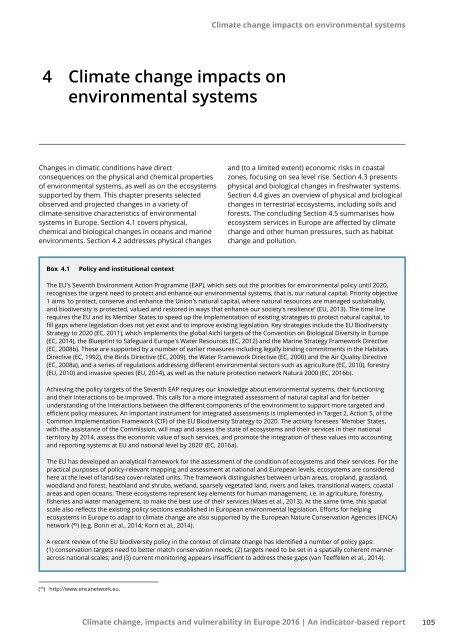Climate change impacts and vulnerability in Europe 2016
document
document
You also want an ePaper? Increase the reach of your titles
YUMPU automatically turns print PDFs into web optimized ePapers that Google loves.
<strong>Climate</strong> <strong>change</strong> <strong>impacts</strong> on environmental systems<br />
4 <strong>Climate</strong> <strong>change</strong> <strong>impacts</strong> on<br />
environmental systems<br />
Changes <strong>in</strong> climatic conditions have direct<br />
consequences on the physical <strong>and</strong> chemical properties<br />
of environmental systems, as well as on the ecosystems<br />
supported by them. This chapter presents selected<br />
observed <strong>and</strong> projected <strong>change</strong>s <strong>in</strong> a variety of<br />
climate‐sensitive characteristics of environmental<br />
systems <strong>in</strong> <strong>Europe</strong>. Section 4.1 covers physical,<br />
chemical <strong>and</strong> biological <strong>change</strong>s <strong>in</strong> oceans <strong>and</strong> mar<strong>in</strong>e<br />
environments. Section 4.2 addresses physical <strong>change</strong>s<br />
<strong>and</strong> (to a limited extent) economic risks <strong>in</strong> coastal<br />
zones, focus<strong>in</strong>g on sea level rise. Section 4.3 presents<br />
physical <strong>and</strong> biological <strong>change</strong>s <strong>in</strong> freshwater systems.<br />
Section 4.4 gives an overview of physical <strong>and</strong> biological<br />
<strong>change</strong>s <strong>in</strong> terrestrial ecosystems, <strong>in</strong>clud<strong>in</strong>g soils <strong>and</strong><br />
forests. The conclud<strong>in</strong>g Section 4.5 summarises how<br />
ecosystem services <strong>in</strong> <strong>Europe</strong> are affected by climate<br />
<strong>change</strong> <strong>and</strong> other human pressures, such as habitat<br />
<strong>change</strong> <strong>and</strong> pollution.<br />
Box 4.1<br />
Policy <strong>and</strong> <strong>in</strong>stitutional context<br />
The EU's Seventh Environment Action Programme (EAP), which sets out the priorities for environmental policy until 2020,<br />
recognises the urgent need to protect <strong>and</strong> enhance our environmental systems, that is, our natural capital. Priority objective<br />
1 aims 'to protect, conserve <strong>and</strong> enhance the Union's natural capital, where natural resources are managed susta<strong>in</strong>ably,<br />
<strong>and</strong> biodiversity is protected, valued <strong>and</strong> restored <strong>in</strong> ways that enhance our society's resilience' (EU, 2013). The time l<strong>in</strong>e<br />
requires the EU <strong>and</strong> its Member States to speed up the implementation of exist<strong>in</strong>g strategies to protect natural capital, to<br />
fill gaps where legislation does not yet exist <strong>and</strong> to improve exist<strong>in</strong>g legislation. Key strategies <strong>in</strong>clude the EU Biodiversity<br />
Strategy to 2020 (EC, 2011), which implements the global Aichi targets of the Convention on Biological Diversity <strong>in</strong> <strong>Europe</strong><br />
(EC, 2014), the Bluepr<strong>in</strong>t to Safeguard <strong>Europe</strong>'s Water Resources (EC, 2012) <strong>and</strong> the Mar<strong>in</strong>e Strategy Framework Directive<br />
(EC, 2008b). These are supported by a number of earlier measures <strong>in</strong>clud<strong>in</strong>g legally b<strong>in</strong>d<strong>in</strong>g commitments <strong>in</strong> the Habitats<br />
Directive (EC, 1992), the Birds Directive (EC, 2009), the Water Framework Directive (EC, 2000) <strong>and</strong> the Air Quality Directive<br />
(EC, 2008a), <strong>and</strong> a series of regulations address<strong>in</strong>g different environmental sectors such as agriculture (EC, 2010), forestry<br />
(EU, 2010) <strong>and</strong> <strong>in</strong>vasive species (EU, 2014), as well as the nature protection network Natura 2000 (EC, <strong>2016</strong>b).<br />
Achiev<strong>in</strong>g the policy targets of the Seventh EAP requires our knowledge about environmental systems, their function<strong>in</strong>g<br />
<strong>and</strong> their <strong>in</strong>teractions to be improved. This calls for a more <strong>in</strong>tegrated assessment of natural capital <strong>and</strong> for better<br />
underst<strong>and</strong><strong>in</strong>g of the <strong>in</strong>teractions between the different components of the environment to support more targeted <strong>and</strong><br />
efficient policy measures. An important <strong>in</strong>strument for <strong>in</strong>tegrated assessments is implemented <strong>in</strong> Target 2, Action 5, of the<br />
Common Implementation Framework (CIF) of the EU Biodiversity Strategy to 2020. The activity foresees 'Member States,<br />
with the assistance of the Commission, will map <strong>and</strong> assess the state of ecosystems <strong>and</strong> their services <strong>in</strong> their national<br />
territory by 2014, assess the economic value of such services, <strong>and</strong> promote the <strong>in</strong>tegration of these values <strong>in</strong>to account<strong>in</strong>g<br />
<strong>and</strong> report<strong>in</strong>g systems at EU <strong>and</strong> national level by 2020' (EC, <strong>2016</strong>a).<br />
The EU has developed an analytical framework for the assessment of the condition of ecosystems <strong>and</strong> their services. For the<br />
practical purposes of policy-relevant mapp<strong>in</strong>g <strong>and</strong> assessment at national <strong>and</strong> <strong>Europe</strong>an levels, ecosystems are considered<br />
here at the level of l<strong>and</strong>/sea cover-related units. The framework dist<strong>in</strong>guishes between urban areas, cropl<strong>and</strong>, grassl<strong>and</strong>,<br />
woodl<strong>and</strong> <strong>and</strong> forest, heathl<strong>and</strong> <strong>and</strong> shrubs, wetl<strong>and</strong>, sparsely vegetated l<strong>and</strong>, rivers <strong>and</strong> lakes, transitional waters, coastal<br />
areas <strong>and</strong> open oceans. These ecosystems represent key elements for human management, i.e. <strong>in</strong> agriculture, forestry,<br />
fisheries <strong>and</strong> water management, to make the best use of their services (Maes et al., 2013). At the same time, this spatial<br />
scale also reflects the exist<strong>in</strong>g policy sections established <strong>in</strong> <strong>Europe</strong>an environmental legislation. Efforts for help<strong>in</strong>g<br />
ecosystems <strong>in</strong> <strong>Europe</strong> to adapt to climate <strong>change</strong> are also supported by the <strong>Europe</strong>an Nature Conservation Agencies (ENCA)<br />
network ( 45 ) (e.g. Bonn et al., 2014; Korn et al., 2014).<br />
A recent review of the EU biodiversity policy <strong>in</strong> the context of climate <strong>change</strong> has identified a number of policy gaps:<br />
(1) conservation targets need to better match conservation needs; (2) targets need to be set <strong>in</strong> a spatially coherent manner<br />
across national scales; <strong>and</strong> (3) current monitor<strong>in</strong>g appears <strong>in</strong>sufficient to address these gaps (van Teeffelen et al., 2014).<br />
( 45 ) http://www.encanetwork.eu.<br />
<strong>Climate</strong> <strong>change</strong>, <strong>impacts</strong> <strong>and</strong> <strong>vulnerability</strong> <strong>in</strong> <strong>Europe</strong> <strong>2016</strong> | An <strong>in</strong>dicator-based report<br />
105


